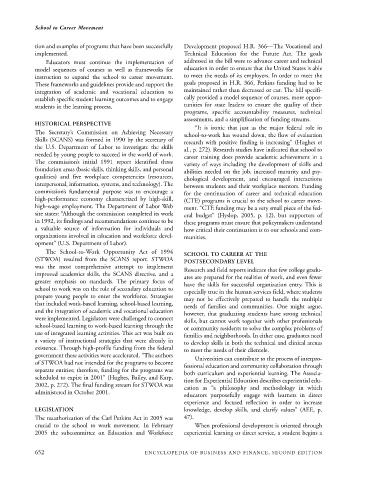Page 675 - Encyclopedia of Business and Finance
P. 675
eobf_S 7/5/06 3:21 PM Page 652
School to Career Movement
tion and examples of programs that have been successfully Development proposed H.R. 366—The Vocational and
implemented. Technical Education for the Future Act. The goals
Educators must continue the implementation of addressed in the bill were to advance career and technical
model sequences of courses as well as frameworks for education in order to ensure that the United States is able
instruction to expand the school to career movement. to meet the needs of its employers. In order to meet the
These frameworks and guidelines provide and support the goals proposed in H.R. 366, Perkins funding had to be
integration of academic and vocational education to maintained rather than decreased or cut. The bill specifi-
establish specific student learning outcomes and to engage cally provided a model sequence of courses, more oppor-
students in the learning process. tunities for state leaders to ensure the quality of their
programs, specific accountability measures, technical
assessments, and a simplification of funding streams.
HISTORICAL PERSPECTIVE
“It is ironic that just as the major federal role in
The Secretary’s Commission on Achieving Necessary school-to-work has wound down, the flow of evaluation
Skills (SCANS) was formed in 1990 by the secretary of research with positive finding is increasing” (Hughes et
the U.S. Department of Labor to investigate the skills
al., p. 272). Research studies have indicated that school to
needed by young people to succeed in the world of work.
career training does provide academic achievement in a
The commission’s initial 1991 report identified three
variety of ways including the development of skills and
foundation areas (basic skills, thinking skills, and personal
abilities needed on the job, increased maturity and psy-
qualities) and five workplace competencies (resources, chological development, and encouraged interactions
interpersonal, information, systems, and technology). The between students and their workplace mentors. Funding
commission’s fundamental purpose was to encourage a for the continuation of career and technical education
high-performance economy characterized by high-skill, (CTE) programs is crucial to the school to career move-
high-wage employment. The Department of Labor Web ment. “CTE funding may be a very small piece of the fed-
site states: “Although the commission completed its work eral budget” (Hyslop, 2005, p. 12), but supporters of
in 1992, its findings and recommendations continue to be these programs must ensure that policymakers understand
a valuable source of information for individuals and how critical their continuation is to our schools and com-
organizations involved in education and workforce devel- munities.
opment” (U.S. Department of Labor).
The School-to-Work Opportunity Act of 1994 SCHOOL TO CAREER AT THE
(STWOA) resulted from the SCANS report. STWOA POSTSECONDARY LEVEL
was the most comprehensive attempt to implement
Research and field reports indicate that few college gradu-
improved academics skills, the SCANS directive, and a
ates are prepared for the realities of work, and even fewer
greater emphasis on standards. The primary focus of have the skills for successful organization entry. This is
school to work was on the role of secondary education to especially true in the human services field, where students
prepare young people to enter the workforce. Strategies may not be effectively prepared to handle the multiple
that included work-based learning, school-based learning, needs of families and communities. One might argue,
and the integration of academic and vocational education however, that graduating students have strong technical
were implemented. Legislators were challenged to connect skills, but cannot work together with other professionals
school-based learning to work-based learning through the or community residents to solve the complex problems of
use of integrated learning activities. This act was built on families and neighborhoods. In either case, graduates need
a variety of instructional strategies that were already in to develop skills in both the technical and clinical arenas
existence. Through high-profile funding from the federal to meet the needs of their clientele.
government these activities were accelerated. “The authors Universities can contribute to the process of interpro-
of STWOA had not intended for the programs to become fessional education and community collaboration through
separate entities; therefore, funding for the programs was
both curriculum and experiential learning. The Associa-
scheduled to expire in 2001” (Hughes, Bailey, and Karp,
tion for Experiential Education describes experiential edu-
2002, p. 272). The final funding stream for STWOA was
cation as “a philosophy and methodology in which
administered in October 2001.
educators purposefully engage with learners in direct
experience and focused reflection in order to increase
LEGISLATION knowledge, develop skills, and clarify values” (AEE, p.
The reauthorization of the Carl Perkins Act in 2005 was 47).
crucial to the school to work movement. In February When professional development is oriented through
2005 the subcommittee on Education and Workforce experiential learning or direct service, a student begins a
652 ENCYCLOPEDIA OF BUSINESS AND FINANCE, SECOND EDITION

